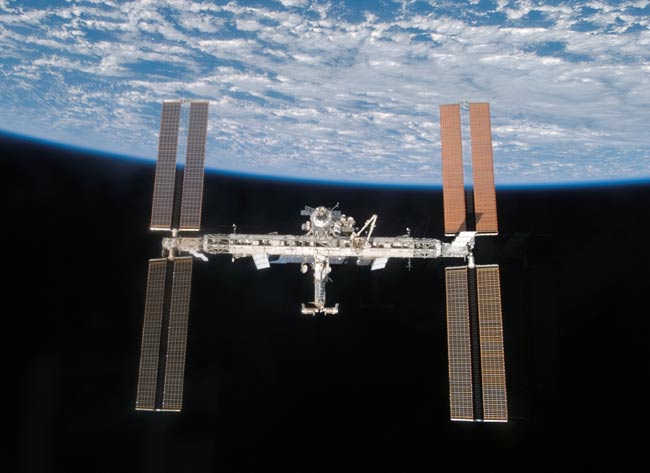NASA Details Plan to Open ISS for Outside Use

NASA ispressing ahead with plans to use part of the International Space Station (ISS)as a national laboratory, a move that would reserve about half of the outpost'sU.S. science facilities for outside use by 2011.
The planhinges on the completion of the half-built $100billion space station by September 2010, when NASA's shuttle fleetis due to retire, the space agency said Monday.
"What we're trying to do is open up the U.S. segment of thespace station to be utilized by a variety of folks, both governmental and maybecommercial, in the future so that we can take the maximum advantage of thespace station that we're in the process of assembling right now," saidBill Gerstenmaier, NASA's associate administrator for space operations, duringa teleconference with reporters.
In lateMay, NASA presented Congress with a 14-pagereport detailing the agency's plan to use the U.S. segment of the ISS as anational laboratory as directed under the NASA Authorization Act of 2005.
NASA andits international partners plan at least 12 more space shuttle flights tocomplete ISS construction by 2010. Still awaiting launch to the station are theEuropean Space Agency's Columbus module, Japan's three-partKibo laboratory, additional Russian-built modules, as well assupporting solar arrays, connecting nodesand other hardware.
"Previously,we had anticipated that all the research conducted on the station would beresearch within NASA's mission portfolio," said Mark Uhran, the spaceagency's associate administrator for the ISS. "Now what we're looking todo is make the facility available to other government agencies or private firmsto pursue their own research interests."
NASA'srestructuring in recent years, which shifted away from earlier ISSscience efforts to a more focused exploration program to support theplanned return of astronauts tothe Moon, led to the surplus of science time available aboard thestation, space agency officials said.
Get the Space.com Newsletter
Breaking space news, the latest updates on rocket launches, skywatching events and more!
The level ofinterest among non-NASA agencies to use the ISS could ultimately decide howlong the space station remains in operation beyond its current 2016 designlifetime, they added.
"Technically,the space station could fly to 2020 or 2022," Gerstenmaier said, addingthat a decision on whether to extend the station's lifetime would have to bemade around 2014. "What really drives the practical lifetime of the spacestation is how useful it is and does it fit a niche."
Whencomplete, the space station's pressurized U.S. science facilities will includethe 12 experiment racks inside NASA's Destiny laboratory already in orbit, aswell as five others inside both the Columbus and Kibo laboratories. NASA hasalso reserved about five payload slots on the Kibo laboratory's porch-likeexposed platform and has room for science experiments on other U.S.-builtexternal cargo carriers.
About halfof all those U.S. assets are expected to be available for use by privatecommercial enterprises or non-NASA government agencies, Uhran said. Sciencepayloads will be skewed to include more automation, since the amount of crewtime available for non-NASA work remains to be determined, as well as focusedon experiments that return data only, rather than require a return trip to Earth,he added.
While NASAwould continue to assume the current operational and maintenance costs of theISS, as well as those to launch astronaut crews and cargo, national laboratoryusers would be responsible for the cost of their payloads and research underthe current plan. The anticipated cost of NASA's ISS operations once thestation is complete is estimated at about $1.5 billion per year, Gerstenmaiersaid.
The spaceagency is also relying on the anticipated availability of private launchservices to the ISS, such as those sponsored by NASA's Commercial OrbitalTransportation Services program, as well as the station's planned expansion toa six-person crew in 2009 to maintain the orbital laboratory.
"Thesuccess of this plan does clearly rely on being able to reach a six-personcrew," Uhran said.
- NASA Open to ISS Use by Industry, U.S. Agencies
- SPACE.com Video Interplayer: Space Station Power Up with STS-117
- Complete ISS Expedition Coverage
Join our Space Forums to keep talking space on the latest missions, night sky and more! And if you have a news tip, correction or comment, let us know at: community@space.com.

Tariq is the Editor-in-Chief of Space.com and joined the team in 2001, first as an intern and staff writer, and later as an editor. He covers human spaceflight, exploration and space science, as well as skywatching and entertainment. He became Space.com's Managing Editor in 2009 and Editor-in-Chief in 2019. Before joining Space.com, Tariq was a staff reporter for The Los Angeles Times covering education and city beats in La Habra, Fullerton and Huntington Beach. In October 2022, Tariq received the Harry Kolcum Award for excellence in space reporting from the National Space Club Florida Committee. He is also an Eagle Scout (yes, he has the Space Exploration merit badge) and went to Space Camp four times as a kid and a fifth time as an adult. He has journalism degrees from the University of Southern California and New York University. You can find Tariq at Space.com and as the co-host to the This Week In Space podcast with space historian Rod Pyle on the TWiT network. To see his latest project, you can follow Tariq on Twitter @tariqjmalik.










